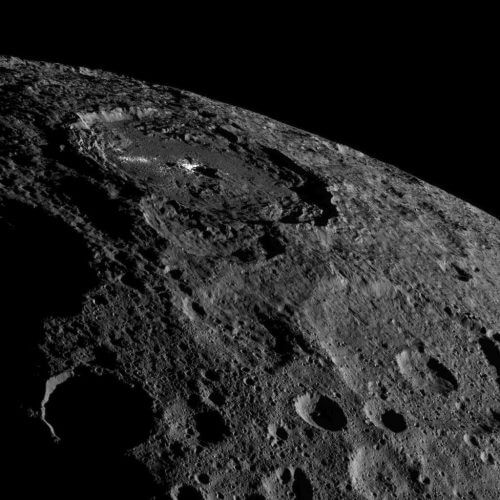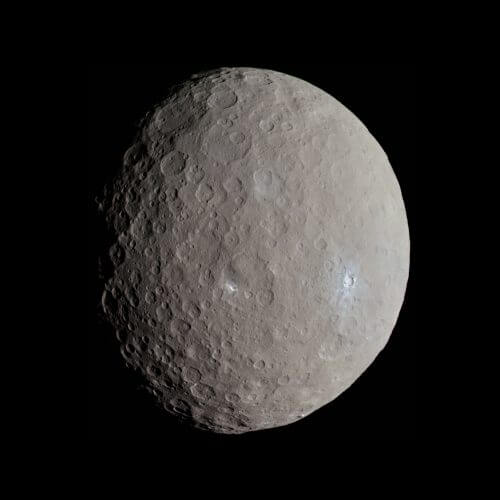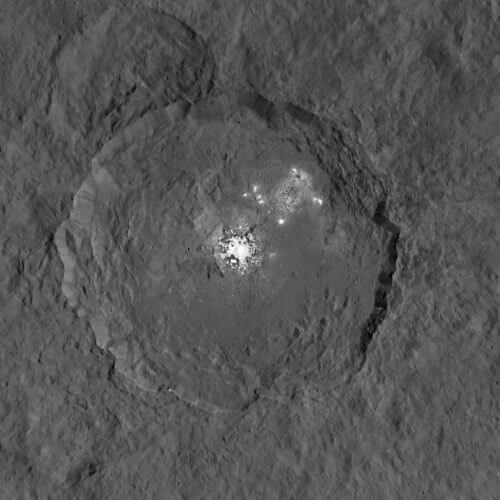Summary of findings from NASA's "Dawn" probe mission, which has been investigating the dwarf planet Ceres, located in the asteroid belt, since 2015.

The Dawn spacecraft entered orbit around the asteroid Keres on March 6.3.2015, XNUMX and has been circling and photographing it ever since. She is already working beyond the time planned for her. Towards the end of its work program, a new proposal was made to take it out of its orbit around the asteroid and into orbit towards a third asteroid, but in the end it was decided to keep it in orbit around Keres until its fuel supply runs out. in the past report Because the probe is designed to become an eternal satellite of Keres, even after it ceases to function.
To date, over 20,000 photographs have been sent to Earth. The image depicted is of a planet, in this case a dwarf star, almost featureless. Lots of craters and very little tectonic activity. Very few grooves were observed in it. A place where there is an impressive system of grooves is in the Yalide crater, which is 270 km in diameter. There is a cluster of depressions 1.5 km wide (1). From counting the craters, it became clear that there are no craters on Keres that are large in diameter - 280 km. It has 16 craters with a diameter greater than 100 km (2). The most famous crater is the Occator crater because of the bright spots discovered inside it. Interesting craters are the Kupalo crater which is 26 km in diameter and has a straight bottom and light stripes on its sides (3), the Urvana crater which is 163 km in diameter and has a bump in the center with a bright area on it. Near the bulge a ridge of hills. There is also a network of cracks, straight areas and rough areas on the floor of the crater. In the Dantu crater with a diameter of 125 km, there are isolated bright areas, long cracks and a zigzag structure in the center (4) and the Haunlani crater with a diameter of 34 km. It has clear signs of rockfalls. In the center is a ridge. Its floor is almost free of craters (5).

The most prominent body on Keres is a mountain with very steep slopes that rises to a height of 5 km and has an elliptical base that is 17.6 km long. This mountain was named Ahuna Mons. It looks like a truncated pyramid. reminiscent of Horst in form. Such a form of landscape exists in Israel and it is the citadel. It is believed that this is a mountain that grew as a result of cryovolcanism. It was built following repeated eruptions of salt-saturated water that froze immediately after bursting to the surface. This mountain has no parallel whatsoever on Keres (6).
130 bright areas are scattered over the surface of Keres. The most prominent of them is the Occator crater (7). It is estimated that the bright spots were created as a result of heat that was released when various bodies hit the asteroid's ground. The many impacts resulted in the melting of a mixture of rocky material, ice and salts that erupted from the crust (8). It turned out that the bright spots in the Occator crater lighten up during the day and change shape. They explain that this phenomenon has something to do with the volatile substances that evaporate due to the sun's radiation. When these areas are on the side lit by the sun and form plumes that reflect sunlight. These plumes evaporate quickly, lose their ability to reflect light and create the changes that the viewer sees (9). The photographs showed that the light reflected from the bright areas was bluer than other bright spots. The conclusion reached by the researchers is that it is probably a type of magnesium called hexsahydrite, similar to Epsom on Earth (10). Phyllosilicates were also found on Keres.

All materials containing water on a hook cover an area smaller than 1 km. This is probably water ice below the surface. Their origin is probably due to the impact of an asteroid on a hook or in a local rockslide (11). Water was also found in the 10 km diameter Oxo crater (12). In the high latitudes of the Northern Hemisphere there is a large amount of hydrogen (13).
As for the internal structure of the hook, the assessment is that there is no complete separation between the nucleus and the shell and the membrane. It is a rocky core and above it a mantle which is a mixture of ice, water and rocky materials and is 190-70 km thick. Since the separation is partial, it is estimated that in the past Keres was a hot body, but there was no complete separation between the water and the volatile substances from the rocky components. It may be and there is evidence that the inside of Cress is still warm. The source of heat in radioactive materials (14).
The researchers discovered on Keres high-energy particles originating from the solar wind. Two possibilities have been put forward to explain the phenomenon. According to one explanation for the hook a weak atmosphere was ionized by these particles coming from the sun that created a shock wave when the solar wind was deflected. The second explanation says that the salty interior of a hook drives an electric flux that creates a magnetic field that deflects the solar wind (11).
Sources
- PIA 20969 :"Dawn LAMO image 207
- Brooks Hays: “Why are there so few large craters in dwarf planet Ceres?"26.7.2016
- Stephen Clark - "NASA published tantalizing close-ups of dwarf planet Ceres” 12.1.2016
- Marc Rayman – “Dawn spiraling in towards Ceres"4.12.2015
- "New Ceres images show bright craters” 20.4.2016
- "Ceres: The tiny world where volcanoes erupt ice"1.9.2016
- Marc Rayman – “Dawn imaging in close Ceres orbit"10.1.2016
- Stephen Clark – "Dawn mission expected to go into overtime Ceres"6.4.2016
- Tomazo Nowakuski – "Life on Ceres mysterious changes in the bright spots still baffle scientists" 27.5.2016
- Stephen Clark – “With widespread salts and ices, Ceres in a class of its own"10.12.2016
- "Dawn spacecraft at Ceres: craters, cracks and cryovolcanos"5.9.2016
- Marc Rayman – “One year on station at Ceres"5.4.2016
- Stephen Clark – “Dawn mission expected to go into overtime at Ceres"6.4.2016
- Charless Q. Choi – “Icy dwarf planet may have a warm heart"3.8.2016

One response
Thanks for the information, it helped us in our research work